 I have been itching to drop by Zoobic Safari ever since they opened. When I finally got the opportunity to visit it last weekend, I was pleasantly surprised to learn that it was more than just seeing tigers up close, it also meant interacting with some of the other animals as we walked around the zoo.
I have been itching to drop by Zoobic Safari ever since they opened. When I finally got the opportunity to visit it last weekend, I was pleasantly surprised to learn that it was more than just seeing tigers up close, it also meant interacting with some of the other animals as we walked around the zoo.
Table of Contents
Brief Background
Zoobic Safari covers about 25 hectares of the Subic Naval Base in the province of Pampanga in the Philippines. Nestled within the Ilanin Forest, it makes good use of the naturally occurring fauna and sloping hills to its advantage.
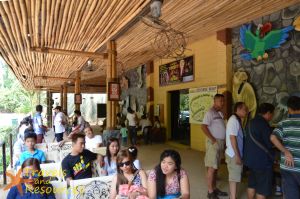
Ticket Area
Apart from their famous tigers, the other animals found here include lionesses, crocodiles, snakes, lizards, camels, miniature horses, wild boar, ostriches, donkeys, and different bird species.
At PhP 545 per person, the entrance fee can be considered a bargain, especially when it is compared to zoos outside the Philippines. In addition to this, pet owners will most likely confirm that maintaining a dog or cat is no joke when it comes to expenses, so when we talk about an entire zoo, the rate is as good as it gets.
Incorporated in the entrance fee are the Tiger Ride, visits to the Bird and Serpentine Sanctuaries, and the viewing of crocodiles at Croco Loco. It also includes a quick visit to an Aeta Village to catch a glimpse of their native dances.

Ticket Area
Taking pictures of all the animals is free of charge. However, interacting with specific ones comes with a small fee. Priced between PhP 20 and PhP100, the money is typically used for food which can be given to the Bearcats, Parakeets, and Crocodiles. For the Tigers, an Aeta guide specializing in this dangerous predator will be the one charged with the feeding.
The money collected for pictures holding the Owl, Baby Crocodile, Tiger Cubs, and riding the Miniature Horse is pooled together to help the entire zoo.
[The Tiger Cubs are not always available for pictures, though.]
Finally, the good news is that parking is not a problem. And the better news is that there are quite a lot of trees to park under. This way, you won’t need to fiddle with that sun shade before leaving your vehicle.
Suggested Attire
Zoobic Safari is best enjoyed during the dry season of September to June, with the bulk of visitors arriving in the summer months of March to May. During this period, as many as 2,000 visitors can be accommodated in a single day.
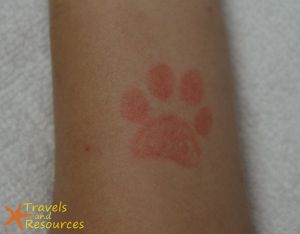
Entrance Stamp
One of the major reasons why it is best during this period is the presence of dust. Ilanin Forest has quite a bit of rich top soil, but its proximity to Mount Pinatubo meant that tons of fine dust was dumped on Subic Naval Base during the 1991 eruption.
While this can be a minor inconvenience during the dry season, the dust can turn to fine mud in the rainy season. A torrential downpour can dampen the experience of visitors. Apart from the difficulty of walking in the almost clay-like fine mud, the animals will most likely be hiding in their shelters.
With the sun at its hottest point this time of the year, there are two things to take into consideration when dressing for Zoobic Safari – heat and dust.
Footwear
Much like my recommendation for Dinosaurs Island, visitors may want to consider wearing closed-toed shoes to minimize the amount of dust adhering to the feet.
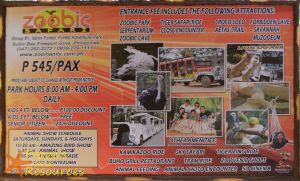
Sign
While some may consider slippers to be more convenient, they expose the feet. And with more surfaces to cling to, more dust can be expected to be tracked into one’s vehicle.
[Our vehicle floor and scuff plates were caked in dust on the way home.]
Socks are not a requirement, as there are hardly any pebbles to get lodged in shoes. So boat shoes or sneakers without socks are fine. However, if you want to add a kick to your pictures, nothing beats a pair of hiking boots combined with white socks and khaki walking shorts.
As far as the ladies are concerned, anything with a high heel is best avoided since the terrain is a combination of uneven concrete and lightly packed soil. Apart from difficulties with balance, high heels may end up digging into the exposed ground.
Clothes
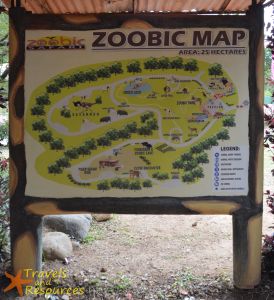
Map
A collarless T-shirt and walking shorts would be best at keeping the high temperatures at bay for the gentlemen. The short sleeves expose as much skin to the air to allow perspiration to dry a little faster.
The ladies have much more flexibility when it comes to clothes as they can wear anything from blouses and shorts to sundresses. I would suggest wearing light materials instead of the thick and heavy ones.
While more exposed skin translates to cooler temperatures, it also means that there is more surface for dust to cling to. To help minimize this, some of the gentlemen and ladies in our tour group opted to wear long pants and long sun dresses.
One bit of good news is that the Zoobic Park is dotted with areas where cool mist is sprayed at the guests. However, it currently covers only the initial part of the park with the rest to probably follow in the future.
Others
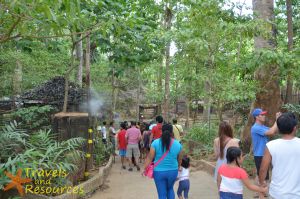
Pathway
There are rest rooms conveniently located in all the major exhibits. With running water readily available, a face towel would be a good idea to carry with you.
Hats or umbrellas aren’t a necessity because all the exhibits and pathways are either under roofing or netting. However, if one is extremely sensitive to the sun, they can still be of use.
You may also want to pack an extra shirt and leave it in the car. This way, you can change right before leaving the parking area.
Getting Around
There are two main ways of getting around the Zoobic Safari grounds – riding the Tram or taking your own vehicle.
The Tram
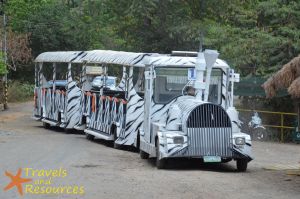
Tram
The tram looks like a short train, with a lead car pulling two coaches. Unlike typical Trams, the ones used in Zoobic Safari are painted to resemble tiger or zebra stripes. And instead of running on forged steel wheels over metal tracks, they run on rubber tires over dirt roads.
While riding the Tram is not a requirement, it is recommended because it allows everyone, including the driver, to enjoy the scenery as it travels around the Zoobic Safari grounds.
The total cost to ride the Tram is PhP 70 per person, including kids. This translates into PhP 50 allotted for the fare and PhP 20 covering the environmental fee.
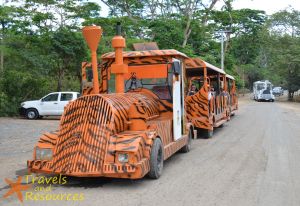
Tram
The convenience of the ride may be felt the most during the last leg of tour. This is when the Tram passes through an open area known as the Savannah. It is basically a huge pen where different animals can roam about together.
[Tigers aren’t allowed to roam free here because it would be more like a buffet than a Savanna.]
Finally, the main drawback of taking the tram is exposure to dust and heat. Since the lead vehicle can kick up dust, passengers will inevitably get some of it on their bodies.
[It’s not heavy enough to turn people white, but it can get in the eye if the wind blows.]
Own Vehicle
Another option for visitors to go around the Zoobic Safari grounds is to take their own vehicles.
Just to be clear, using your own vehicle doesn’t give you free reign of the place. Since everyone, including those in vehicles, are assigned to a tour group, you will need to follow a Tram as your group advances. So every time the Tram stops, you will need to stop too.
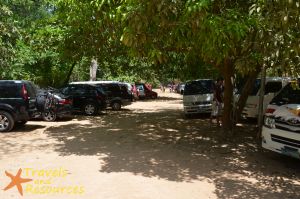
Parking Area
While this may sound limiting, there are several reasons for this. Firstly, Tour Guides keep track of the number of people in their groups at all times, including those in vehicles. This ensures that none of the passengers in your vehicle will be left behind or end up as food for the tigers or crocodiles.
Secondly, being with a tour group means that vehicle owners get the added bonus of hearing all the information shared by the guide.
The benefits of taking your own vehicle include having the opportunity to turn that air conditioner between stops. If the vehicle is a car, it may also be helpful for the elderly or persons with disabilities due to it being lower to the ground. By contrast, Trams have a high ground clearance and people need to stretch a bit to get up and down.
The main tradeoff of taking your own vehicle is that the interior will collect a lot of dust as the number of times people get in and out increases. Another is that you can expect dust to settle on the exterior of the vehicle from shuttling to the different exhibits.
Finally, if the driver also happens to be the one taking pictures, taking photographs will be impossible due to safety concerns.
[Running over an animal in the Savannah while taking pictures won’t be good for everyone concerned.]
Zoobic Park
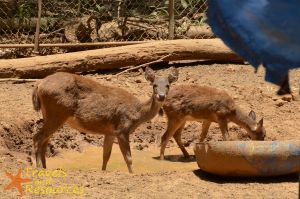
Deer
I was pleasantly surprised by the type of animal attractions as we toured Zoobic Park. Some of the animals were different from the ones I had seen in the Puerto Princesa, Bohol, and Baluarte.
One of the nicer things about this park is that is misters are scattered around the first half of the path, ending a little after the bird sanctuary. This means that both people and birds get to benefit from the cooler temperature brought about by the fine water in the air.
[It looks like they may add more of them to the remaining path.]
Birds
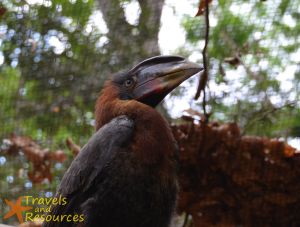
Hornbill
The first set of exhibits include various types of birds. There were Ostriches, Owls, Hornbills, Parrots, and even Parakeets. But what sets this zoo apart from the ones I have visited in Palawan, Bohol, and those outside the country, is that visitors can interact with the birds.
However, I need to clarify that only certain areas allow people to get near or touch them. The reason for this is to prevent injuries to visitors and to the animals themselves.
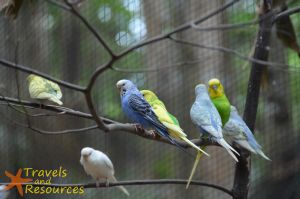
Parakeet
The first picture opportunity involved a brown owl sitting on a perch. For PhP 50, one will be able to get real close to it or even have it rest on one’s arm. The second photo opportunity involves Parakeets. For the same amount, visitors can purchase a pack of bird seed and have a flock of Love Birds land on their hands to pick it off.
The thing that caught my attention was a pair of Hornbills that greeted our group when we entered the bird sanctuary. Perching on the top of the entrance, they were quite curios about the new set of visitors coming to see them. And while they maintained a minimum distance of two-arm lengths from us, they kept everyone in sight as we walked around. Their being brave made for great photography opportunities as even an 18-55mm kit lens could do the job.
Asian Small Clawed Otters
While I have seen otters in zoos abroad, they were always behind a plate of glass. And the one thing these glass slates were good as was to isolate the sound they made.

Asian Clawed Otter
In Zoobic Safari, the Asian Small Clawed Otters reside in open-air pens. And to keep them from escaping, the walls surrounding their home were high enough to be out of reach.
Getting back the noises they made, I actually heard their loud squeals several meters away. As I walked deeper into the zoo, I turned my head left and right to see where the sound emanated from. It was only after getting to their pen that I realized the sound didn’t come from around me; it came from below.
Yup, their pen, which included a swimming area, was located below ground. And as visitors gazed down at the three Asian Small Clawed Otters, they would look up and squeal with excitement. And when I say squeal, I mean that as a literal ear-piercing one.
Bearcats
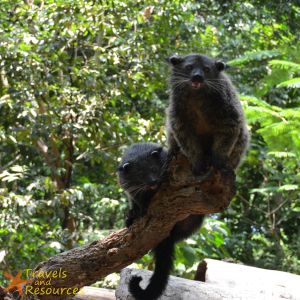
Bearcat
The last time I came across a Bearcat, it was back in the Crocodile Farm of Palawan. With a menacing eyes and coarse fur, they looked like something out of the neither world. But after having one climb all over me, I learned they can be gentle creatures.
In Zoobic Park, people have the opportunity to feed a pair of Bearcats atop a large branch that is about a meter away. For just PhP 25 per Banana, the food is attached to a long bamboo pole, which can be stretched out in front of them.
In feeding the pair, my nephew chose to patiently maneuver the food to the second Bearcat. He reasoned that the one in front, which was the dominant one, was already well-fed.
[Leave it to kids to help the underdog!]
Miniature Horse
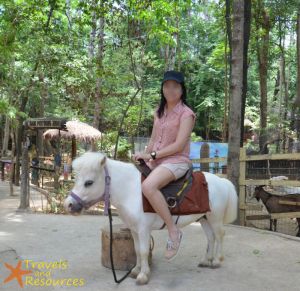
Miniature Horse
The last time I saw a miniature horse, it was pulling an equally small carriage within Baluarte in Vigan. Since I wasn’t able to get up close to one, I never realized how small they were.
[A stuffed toy in the Zoovenir shop was bigger than this little thing!]
And even after my wife and nephew sat on one for a photo session I still couldn’t believe how small they were. They were so small, their heads hardly cleared my waist.
[And I wouldn’t call myself a tall guy.]
Dromedary Camel
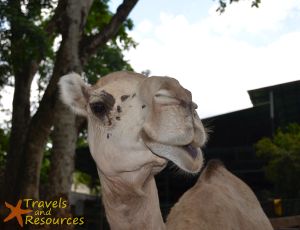
Dromedary Camel
If there is any animal in the Zoobic Park that deserves the title of most photographed, it had to be a particular Dromedary Camel. Instead of staying at the rear of his pen like the others, this one appeared to be welcoming visitors with his crooked, but lovable, smile.
[He would be at hand for pictures, even if you didn’t want him there!]
And while some camels have a reputation for spitting if they didn’t like you, this guy was at his best behavior, smiling for the cameras.
Donkey
Donkeys are somewhat of a rare sight in the Philippines. Carabaos, or Water Buffalos, are more common, with horses coming in a distant second.
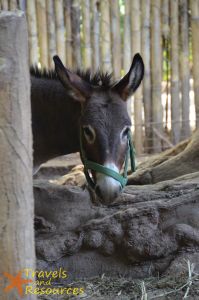
Donkey
So seeing a donkey at Zoobic Park was a pleasant surprise. Firstly, they really look the same as they do in the movies, stance and all. If a stallion can be compared to a confident Marine standing tall, the donkey is more akin to an insecure man with drooping shoulders.
Secondly, they really sound the same as they do in the movies. The braying sound they make is similar to somebody wheezing then yelling with a very hoarse voice.
[It looked and sounded exactly like donkey in the Shrek trilogy!]
And while they were rather shy animals, I did manage to catch one donkey curiously looking at me. Either that or it was sizing me up should one of the tigers get loose. And judging from the pounds I packed on lately, he probably reckoned that you could outrun me when the Tigers plan for a feeding frenzy.
Other Creatures
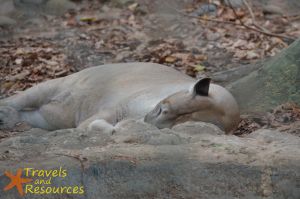
Sleeping Cougar
Being that it was around eleven o’clock in the morning, quite a number of predators could be seen napping. This included the Cougar and one of the female Lions, or Lionesses.
And while I am not exactly big on cats, seeing these big cats peacefully sleeping made me want to take them home.
[I just need to figure a way to keep them sleeping because if they wake up…]
Aeta Trail
The Aeta people are a Philippine tribe that has occupied the Subic area even before the Spaniards arrived. Being nomadic, older clans did not practice farming. To survive, they hunted forest animals, such as wild boar, and gathered fruits as they crisscrossed the land.
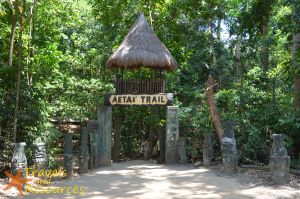
Aeta Trail
Many of the current generation still honor the practices of their ancestors. One of more overlooked things happen to be their habit of gathering fruits. Unlike outsiders, who would pick a tree completely when they stumble upon it, the Aeta only get what they need. They leave what they cannot consume at that moment for other tribesmen who may pass through at a later time.
The Aeta Trail was established in Zoobic Safari to help remind others of the rich practices, such as tribal dances to honor the Dragonfly or to ask for rain. Together with JEST, or the Jungle Environment Survival Training, the Aeta legacy can be kept alive.
Talking pictures of the dances conducted on the ground wasn’t a big problem. However, when the monkey dance required an Aeta to scale a tree, he was up and down so quickly, I didn’t have time to turn my dSLR back on.
To my defense, I wasn’t the only one shocked as our entire tour group let out a collective gasp as he climbed up and down.
[So get your video recorder going and point it at that tree or you’ll miss it.]
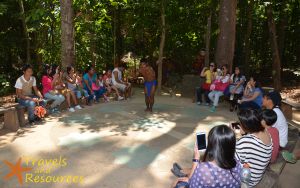
Aeta Tribal Dance
Apart from this, visitors get the chance to fire the same kind of bows and arrows that Aeta hunters would use in the past.
[Actually, it is said that they still use bows and arrows today but I wasn’t able to confirm it at the time of our visit.]
The cost to fire an arrow at a circular target is PhP 20. And if there is one thing I will say, one arrow simply isn’t enough as it can get addicting. First timers may be surprised at the amount of tension used by the bow, which is nowhere near as soft as the toys in malls.
After that first shot, things get a little easier as visitors adjust their aim. That second shot will most likely be a miss, meaning that at least another one will be needed to get it right in the bull’s-eye.
[In our case, we went beyond the third shot because it was fun.]
Savannah
The Savannah is the last leg of our two and a half our tour of Zoobic Safari. Similar to the Bird Sanctuary, it is a large enclosed area where many of the zoo’s tamer animals are allowed to roam free. The main differences are that this place is much larger and doesn’t have a net above it.
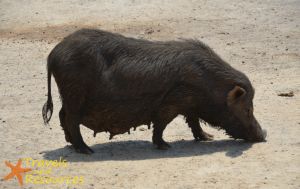
Wild Boar
Some of the residents found here include the menacing Wild Boar, the relaxed Dromedary Camel, and the confident Peacock. There are even a smattering of Goats and Miniature Horses running around the place.
Each group of animals seems to have claimed their own space, which appear to be former ammunition bunkers used by the Americans when they still stayed at Subic Naval Base.
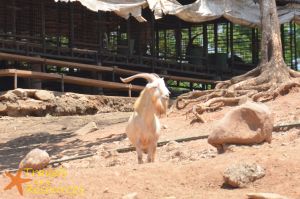
Goat
This is the only area where all of Zoobic Safari’s hunters, such as the Tigers, Lions, and Crocodiles, are banned from entering. The enclosure, though bigger than the Bird Sanctuary and Tiger Feeding Area put together, will end up being one huge buffet for these top predators.
And given that photographers are on a moving vehicle, this is the only other pace, apart from the dancer in Aeta Trail, where a fast shutter speed will be needed. So while the Trams don’t go as fast as railed trains in the Wild West, the bouncing and snaking around animals in the middle of the road means that things go past quickly.
Final Thoughts
And there you have it, part one of our trip to Zoobic Safari. Taking approximately two and a half hours for the entire tour, there are quite a number of animals to see here.
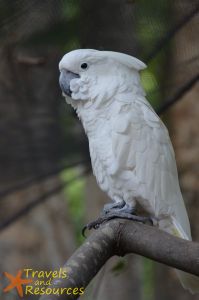
Bird
Based on the information our tour guide provided us, most of the animals here are used to people. And unlike other zoos, visitors get to interact with some of the safer animals, such as the birds, Bearcats, Camels, and Miniature Horses. And depending on the timing, you will even be able to interact with the crocodiles, and tiger cubs.
Time for me to head out. If have the time, try checking out the second part of this series, entitled Zoobic Safari, Part 2 – Tiger Safari Ride, Close Encounters, Croco Loco, and Serpentarium when it comes out in a couple of days. We’ll be covering some of the zoo’s more interesting residents there.
Do’s
- Wear clothes that will help you stay cool.
- Bring a face towel.
- Use closed-toed shoes.
- If wearing slippers, bring a rag to wipe feet on before getting inside the car.
- Consider paying a little for the opportunity to interact with the animals.
Don’ts
- Do not wear shoes with heels.
- Avoid bringing the baby carriage with you at it will accumulate dust.


Comments are closed